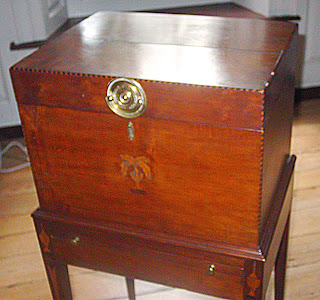Accession #: 1951.0013.0001 and 1970.0002
During
the 1700s and 1800s, affluent members of society acquired sophisticated and
costly beverage accessories, including specialized furniture for storing
drinking vessels. Cellarettes, or bottle chests, were made in fashionable
designs and materials for dining rooms, parlors, or studies. They were both fashionable
and practical, allowing the host to serve a wide assortment of wine and spirits
from the comfort of the room.
Traditionally, the cellarette was made of wood, often
times mahogany, and with a hinged lid, that was frequently equipped with a
lock. The interior was often lined with metal or lead, and
compartmentalized to hold up to twelve bottles or decanters. They came in
a variety of shapes and progressively grew taller, as did the wine bottles, in
the 18th century. Common varieties were oval or rectangular with tapered or fluted
legs on castors and were occasionally hooped with brass bands. Usually, they
were kept under the centre of a sideboard or side table, and were rolled out
for use. In some cases, the box portion of a cellarette could be detached from
its base (you never knew when spirits would need to be hidden from unexpected
guests).
 Wilton
has two contrasting cellarettes in the collection. The first is a small
mahogany English, George III hinged box from the late 18th century
with brass lion head ring handles. Its interior is finished with four
compartments, currently housing glass decanter bottles. The set of 18th
century bottles share the qualities of rounded shoulders and a round glass
stopper, as well as, being decorated with a gold leaf design consisting of
flowers and leaves. Currently
this cellarette is on display in the Randolph study. It makes more sense for
this small piece to be used and portrayed there since it was more likely that
of a personal collection of wines or spirits were kept for aside for the head
of the house and his private guests while in that room, or for his own
recreational use.
Wilton
has two contrasting cellarettes in the collection. The first is a small
mahogany English, George III hinged box from the late 18th century
with brass lion head ring handles. Its interior is finished with four
compartments, currently housing glass decanter bottles. The set of 18th
century bottles share the qualities of rounded shoulders and a round glass
stopper, as well as, being decorated with a gold leaf design consisting of
flowers and leaves. Currently
this cellarette is on display in the Randolph study. It makes more sense for
this small piece to be used and portrayed there since it was more likely that
of a personal collection of wines or spirits were kept for aside for the head
of the house and his private guests while in that room, or for his own
recreational use. |
| 1970.0002 |
The second piece is a much grander cherry American, Federal style cellarette from the early 1800’s. The upper section is considered removable and also consists of a hinged lid with brass hardware. The front has an inlay decoration of a stylized urn with leaves, while the stand is similarly inlaid on square tapering legs. The inlay’s consists of boxwood, ebony and rosewood on this piece. A larger, more elaborate cellarette such as this one, showcased in the Wilton dining room, displays the options of spirits to guests and made it’s accessibility to guests quite easy.
American Decorative Arts Acquisitions . 81. Detroit Institute of Arts, 2007. 53-82. Web. < http://www.jstor.org/stable/23183095>.
Anderson, Jennifer. Mahogany: The Costs of Luxury in Early America. Harvard University Press, September 2012. 340. Web. <http://www.jstor.org/stable/j.ctt2jbszn>.
Fletcher, Brigitte. "Trendy Wine Furniture." Antiques & Fine Art Magazine. <http://www.antiquesandfineart.com/articles/article.cfm?request=431>.


